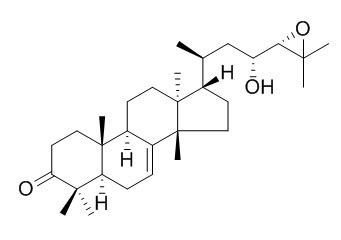Niloticin
Niloticin can be used as a potential natural mosquitocide, it shows strong larvicidal and pupicidal activities, and shows good mosquitocidal activity against Ae. aegypti. It can be used against the larvae of A. aegypti as an effective acetylcholinesterase (AChE) inhibitor.
Inquire / Order:
manager@chemfaces.com
Technical Inquiries:
service@chemfaces.com
Tel:
+86-27-84237783
Fax:
+86-27-84254680
Address:
1 Building, No. 83, CheCheng Rd., Wuhan Economic and Technological Development Zone, Wuhan, Hubei 430056, PRC
Providing storage is as stated on the product vial and the vial is kept tightly sealed, the product can be stored for up to
24 months(2-8C).
Wherever possible, you should prepare and use solutions on the same day. However, if you need to make up stock solutions in advance, we recommend that you store the solution as aliquots in tightly sealed vials at -20C. Generally, these will be useable for up to two weeks. Before use, and prior to opening the vial we recommend that you allow your product to equilibrate to room temperature for at least 1 hour.
Need more advice on solubility, usage and handling? Please email to: service@chemfaces.com
The packaging of the product may have turned upside down during transportation, resulting in the natural compounds adhering to the neck or cap of the vial. take the vial out of its packaging and gently shake to let the compounds fall to the bottom of the vial. for liquid products, centrifuge at 200-500 RPM to gather the liquid at the bottom of the vial. try to avoid loss or contamination during handling.
Plant Physiol Biochem.2023, 201:107795.
Korean J. Medicinal Crop Sci.2021, 29(6):425-433
Korean Journal of Pharmacognosy2018, 49(3):270-277
Environ Toxicol.2023, 38(5):1174-1184.
J. Food Composition and Anal.2022, V 109:104482.
Korean Journal of Pharmacognosy2018, 49(4):349-361
Pest Manag Sci.2023, 79(8):2675-2685.
Mol Nutr Food Res.2024, 68(20):e2400414.
Acta Biochim Pol.2015, 62(2):253-8
Int J Mol Sci.2018, 19(2)
Related and Featured Products
Phytochemistry. 2012 Nov;83:136-43.
Ring A-seco limonoids and flavonoids from the Kenyan Vepris uguenensis Engl. and their antioxidant activity.[Pubmed:
22898386]
METHODS AND RESULTS:
Two A-seco-limonoids, accorded the trivial names, uguenensene and uguenensone and a C-7 prenylated flavonoid, uguenenprenol were isolated from Vepris uguenensis (Rutaceae). In addition, 11 known compounds, Niloticin, chisocheton A, kihadalactone A, limonyl acetate, methyl uguenenoate, 7-O-methylaromadenrin, flindersiamine, 8α,11-elemodiol, tricoccin S₁₃ acetate, skimmianine, and lupeol were isolated. The structures of the compounds were elucidated and characterized by spectroscopic analyses (NMR, GC-MS and IR).
CONCLUSIONS:
Antioxidant activity of the isolated compounds showed that uguenenprenol and 7-O-methylaromadenrin are good antioxidant agents. Significantly high antioxidant activity was also exhibited by 8α,11-elemodiol, which was 72% at 250 μg mL⁻¹ and 57% at 15.62 μg mL⁻¹ when tested with the deoxyribose method. The two liminoids fit nicely into the biosynthetic pathway from Niloticin to methyl uguenenoate.
Med.Chem.Res.,2016, 25(7):1411-9.
In silico molecular docking of niloticin with acetylcholinesterase 1 (AChE1) of Aedes aegypti L. (Diptera: Culicidae): a promising molecular target[Reference:
WebLink]
Synthetic insecticides used in mosquito control program are harmful to environment and also affect other associated organisms. As a choice, plant-based natural compounds proved to be a good alternative to synthetic insecticides.
METHODS AND RESULTS:
In a study, we had reported Niloticin (C30H48O3) from the plant Limonia acidissima L. was effective and disturbed the larval growth of A. aegypti. The main molecular target for many commercially available synthetic mosquitocides is acetylcholinesterase (AChE), which plays a major role in larval knockdown/resistant mechanisms. AChE1 is a serine protease, which fulfills the physiological function of neurotransmitter hydrolysis at synapses. In the present study, we performed molecular docking studies with acetylcholinesterase 1 (AChE1) of A. aegypti with Niloticin (C30H48O3) and compared with commercially available chemical larvicidal compound temephos (C16H20O6P2S3).
CONCLUSIONS:
The docking results revealed that the binding affinities and energy values of Niloticin (−8.4 kcal/mol) were found to be significantly higher than temephos (−4.75 kcal/mol). Both Niloticin (C30H48O3) and temephos (C16H20O6P2S3) showed the same binding residues (THR’58 and HIS’62) on AChE1. Further, Niloticin produced least binding energy (−8.4 kcal/mol), good inhibition constant value (695.18 μM) and high ligand efficiency (0.25) than temephos, suggesting that Niloticin (C30H48O3) could be used against the larvae of A. aegypti as an effective AChE1 inhibitor.
Acta Trop. 2014 Nov;139:67-76.
Effect of niloticin, a protolimonoid isolated from Limonia acidissima L. (Rutaceae) on the immature stages of dengue vector Aedes aegypti L. (Diptera: Culicidae).[Pubmed:
25019220 ]
The aim of the present study was to evaluate the mosquitocidal activity of fractions and a compound Niloticin from the hexane extract of Limonia acidissima L. leaves on eggs, larvae and pupae of Aedes aegypti L. (Diptera: Culicidae).
METHODS AND RESULTS:
In these bioassays, the eggs, larvae and pupae were exposed to concentrations of 2.5, 5.0, 7.5 and 10.0ppm for fractions and 0.5, 1.0, 1.5 and 2.0ppm for compound. After 24h, the mortality was assessed and the LC50 and LC90 values were calculated for larvae and pupae. Per cent ovicidal activity was calculated for eggs after 120h post treatment. Among the sixteen fractions screened, fraction 8 from the hexane extract of L. acidissima generated good mosquitocidal activity against Ae. aegypti. The LC50 and LC90 values of fraction 8 were 4.11, 8.04ppm against Ae. aegypti larvae and 4.19, 8.10ppm against Ae. aegypti pupae, respectively. Further, the isolated compound, Niloticin recorded strong larvicidal and pupicidal activities. The 2ppm concentration of Niloticin showed 100% larvicidal and pupicidal activities in 24h. The LC50 and LC90 values of Niloticin on Ae. aegypti larvae were 0.44, 1.17ppm and on pupae were 0.62, 1.45ppm, respectively. Niloticin presented 83.2% ovicidal activity at 2ppm concentration after 120h post treatment and Niloticin exhibited significant growth disruption and morphological deformities at sub lethal concentrations against Ae. aegypti. The structure of the isolated compound was identified on the basis of single XRD and spectral data ((1)H NMR and (13)C NMR) and compared with literature spectral data.
CONCLUSIONS:
The results indicate that Niloticin could be used as a potential natural mosquitocide.



